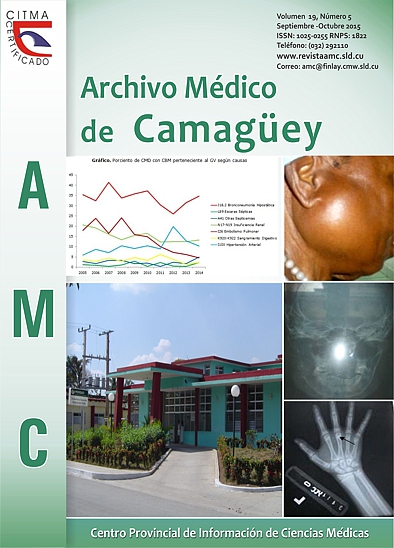Tumor adulto de células de la granulosa del ovario: presentación de un caso
Keywords:
Tumor de ovarioAbstract
RESUMENFundamento: el tumor de células de la granulosa ovárica representa del 2 al 5 % de todos los tumores de ovario. Producen hormonas esteroideas con acciones estrogénicas o androgénicas, por lo que esto facilita su diagnóstico precoz. Se reconocen dos subtipos histopatológicos, uno adulto y otro juvenil.
Objetivo: describir el cuadro clínico y hallazgo histopatológico de una paciente con tumor de células de la granulosa.
Caso clínico: se muestra el caso de una paciente de 49 años de edad que clínicamente presentó signos de virilización progresiva. Se le diagnosticó por estudio de imagen de ultrasonido transvaginal y tomografía axial computarizada un tumor en el ovario derecho, se realizó su intervención quirúrgica y biopsia que dio como resultado tumor de células de la granulosa.
Conclusiones: los tumores que producen estrógenos son los que se encuentran con mayor frecuencia, representando las tres cuartas partes de los tumores de la granulosa. La virilización en la mujer postmenopaúsica por un tumor de células de la granulosa es infrecuente, sin embargo, fue el diagnóstico histopatológico en esta paciente.
Background: ovary granulosa cell tumors represent the 2 to 5 % of all ovary tumors. It produces steroid hormones with estrogenic or androgynous actions which makes easier its early diagnosis. Two histopathological subtypes are recognized: adult and juvenile.
Objective: to describe the clinical manifestation and histopathological founds in a patient with a granulosa cell tumor.
Clinical case: the case of a forty-nine-year-old patient, who clinically presented signs of progressively acquiring male characteristics, is presented. She was diagnosed a tumor in the right ovary by means of a transvaginal ultrasound and a computerized axial tomography. A surgical procedure and a biopsy were conducted; the results of the biopsy confirmed the presence of a granulosa cell tumor.
Conclusions: tumors that produce estrogens are more frequently found and represent the three quarters of the granulosa tumors. Acquiring male characteristics by a granulosa cell tumor in postmenopausal women is infrequent; nevertheless, it was the histopathological diagnosis for this patient.
Downloads
Downloads
Published
How to Cite
Issue
Section
License
Copyright: Camagüey Medical Archive Magazine, offers immediately after being indexed in the SciELO Project; Open access to the full text of the articles under the principle of making available and free the research to promote the exchange of global knowledge and contribute to a greater extension, publication, evaluation and extensive use of the articles that can be used without purpose As long as reference is made to the primary source.
Conflicts of interest: authors must declare in a mandatory manner the presence or not of conflicts of interest in relation to the investigation presented.
(Download Statement of potential conflicts of interest)
The Revista Archivo Médico de Camagüey is under a License Creative Commons Attribution-Noncommercial-No Derivative Works 4.0 International (CC BY 4.0).
This license allows others to distribute, to mix, to adjust and to build from its work, even for commercial purposes, as long as it is recognized the authorship of the original creation. This is the most helpful license offered. Recommended for maximum dissemination and use of licensed materials. The full license can be found at: https://creativecommons.org/licenses/













 22 julio 2025
22 julio 2025